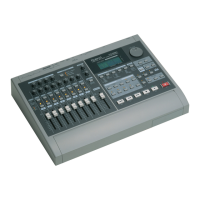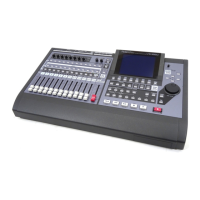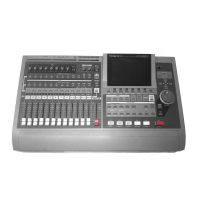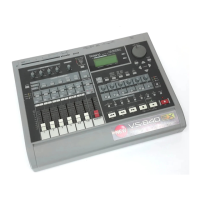25—Automix
Roland VS-2400CD Owner’s Manual www.RolandUS.com 323
The AUTOMIX EDIT screen presents a playlist that shows the currently targeted
Automix data—we’ll explain targeting on the next page. Familiar Home screen tools
appear at the top of the screen (Chapter 8). Edit-related F buttons are visible beneath
the playlist. You can zoom in and out as desired.
Targeting Automix Data
Automix can record and play back more data than can possibly fit onscreen at once.
Targeting allows you to select the Automix data and tracks you want to see and edit.
1. On the AUTOMIX EDIT screen, press F1 (TARGET)—
the TARGET SELECT window appears.
2. Turn the TIME VALUE dial to highlight the desired
target data.
3. Press ENTER/YES to select the new target data, or
EXIT/NO to return to the AUTOMIX EDIT screen without changing the targeted
Automix data.
4. If you pressed ENTER/YES in Step 3, the newly targeted Automix tracks and data
appear in the playlist.
What Automix Data Looks Like
Every time you change a targeted parameter’s value during
Automix recording, the change is captured as an “Automix
event.” Each event appears as a vertical black line on the
AUTOMIX EDIT screen’s playlist—the higher the line, the
higher the parameter value.
When Automix events are selected for editing on the
AUTOMIX EDIT screen, they appear in reverse: an event is
white, and its background is dark.
How Does Automix Editing Work?
Automix editing is very much like the region editing you perform on project audio
tracks. You define a region by setting IN and OUT edit points, and you copy and move
regions using FROM and TO. See Chapter 18 if you need to refresh your memory on the
way region editing works.
When you select a target, you choose both the desired
Automix track and the parameter whose Automix data
you want to edit.
Automix playlist
Currently
targeted
Automix data
When you cursor
to an Automix
track, and arrow
appears to its
left.
This illustration shows a
level parameter’s fade-in.
Selected
VS2400OMUS.book 323 ページ 2006年2月28日 火曜日 午前11時12分

